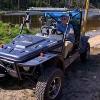By
Xov
Just received delivery of a 2024 AMP Pro. Thought I'd start a thread with my impressions as I use it and learn more. There doesn't seem to be a whole lot of real-world usage information out there on this model. Hope this will help others as they research.
Intended Use Cases
Fire mitigation / slash removal from a 5 acre forested and well-gamble-oaked property. The previous owners thought as much about fire mitigation as I do about fashion: not much.
Snow removal
Stump pulling
General hauling (rock, lumber, etc.)
Weimaraner energy depletion. Wasn't an original use case, but a nice added bonus.
Experiences So Far
Wasn't impressed that two of the bumpers on the underside of the bed where it sits upon the frame were missing. The metal on metal contact has damaged the powder coating and the frame. I expect a little better QC.
I've only put a few hours on it, so not a ton to report on usage. It isn't quiet; it's silent. I can't even detect an electric note from the motor. I removed (and subsequently replaced) the motor cover noticed that the motor is German and made by Schambuller. The motor controller is Italian and made by Dana TM4. Given the operating specs of both I found on the web, I suspect both are higher quality than the previous Navitas (which is supposed to be decent). The motor is rated at 25 hp and 71.5 lb-ft of torque. It feels very powerful. All the torque is delivered instantly, if desired.
The bed is huge and has an electric dump as standard. Great feature but would like it to go up a bit more. Probably not feasible from an engineering perspective, but I want and I need ;).
Power steering is nice, but vague. Probably common to many UTVs, but I am accustomed to more direct results from input. Plan early and plan often.
In our first full day of usage, we hauled about 1/2 as much slash as the entire rest of the year when I was doing it by hand cart. I may get fatter, but I'll also get more done. After a few days of usage, the battery meter has gone down by 1/10th.
Until next time...








Recommended Posts
Create an account or sign in to comment
You need to be a member in order to leave a comment
Create an account
Sign up for a new account in our community. It's easy!
Register a new accountSign in
Already have an account? Sign in here.
Sign In Now